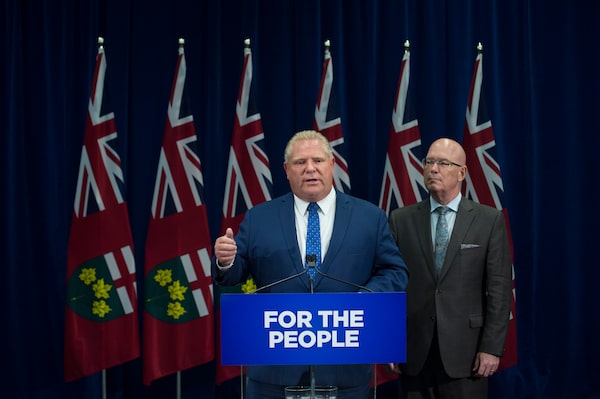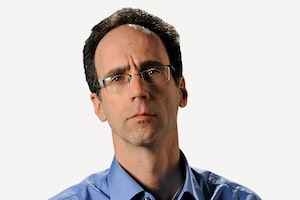Almost since the Charter of Rights and Freedoms took effect in 1982, conservative politicians and critics have spoken out against “activist judges.” But at the same time, a tool for quashing the rulings they did not like sat largely unused, even by conservative governments.
This week, a populist Premier dusted off Section 33 of the Charter – commonly known as the notwithstanding clause – and used it to override a court ruling on constitutional rights. (On Monday, a Superior Court ruled that Ontario’s plan to reduce the size of Toronto City Council violates the freedom of speech of voters and candidates.)
It was a watershed moment, conservative lawyers and academics say. Use of the notwithstanding clause has been rare. But Progressive Conservative Premier Doug Ford says he is open to using it when the need arises for elected legislators to have the last word over appointed judges.
Even among conservative observers, there is a debate over whether his government’s use of the override was the right thing to do.

A crowd gathers outside City Hall during the Fight Back against Ford: Rally to Save our Democracy and Rights event in Toronto on Sept. 12, 2018.Tijana Martin/The Canadian Press
For some, such as Dwight Newman, a conservative-minded professor at the University of Saskatchewan College of Law, the notwithstanding clause is a check on the "imposition of guardianship by a judicial elite.” He views Mr. Ford’s use of that check as an important precedent.
“Each use makes clearer that the clause is politically accessible in the face of other politicians and groups of academics having tried to impose taboos on it,” he said in an e-mail.
For others, though, such as Benjamin Perrin, a former legal adviser to prime minister Stephen Harper, it is a potentially disastrous turning point.
“You start out using the notwithstanding clause on something not a tonne of people care a lot about – the size of the municipal government – and the next thing you know, it’s being used to override rights and freedoms” for vulnerable minorities, such as members of the LGBTQ community, he said in a phone interview. (Mr. Perrin now teaches at the University of British Columbia’s Allard law school.)
Outside of Quebec, which never signed on to the Charter, the notwithstanding clause had been used only four times since 1982. The clause, a compromise that allowed the Charter to be born, was the brainchild of three Western premiers who feared rule by judges. Saskatchewan was the last to use it, invoking it in May so it could pay for non-Catholic students to attend Catholic schools, after a judge ruled that funding scheme violated the Constitution.
That use is widely seen as uncontroversial. “The Saskatchewan court case was unclear, it was difficult to identify a singularly aggrieved party, and the government was right to argue that it was actually protecting rights by using it (to encourage ‘school choice’),” political-science professor Dave Snow of the University of Guelph said in an e-mail.
“By contrast, Ford’s claim that ‘I was elected, the judge was appointed’ paints the clause as simple majoritarianism vs. judicial activism, which, as the Saskatchewan case demonstrates, is far too simplistic.”
If use of Section 33 became virtually taboo, outside of narrow circumstances, it’s because the Charter proved so popular from the beginning that governments feared the public reaction if they defied a court ruling.

Ontario Premier Doug Ford and Steve Clark, Minister of Municipal Affairs and Housing, attend a press conference on Sept. 10, 2018, to address the Ontario Superior Court's decision that the provincial government's legislation to slash the size of Toronto council, was deemed unconstitutional.Fred Lum
The Reform Party loudly criticized judges for perceived “activism” – that is, for expanding constitutional rights. Mr. Harper, in opposition, accused the Supreme Court of acting “illegally” when it read sexual orientation into the list of protected groups in the Charter’s equality section.
And yet even Mr. Harper’s government never used Section 33.
“The right case" didn’t present itself, said Howard Anglin, another former legal adviser to Mr. Harper and now executive director of the Canadian Constitution Foundation, which litigates cases seen as conservative causes. There was consensus it was a legitimate constitutional power, he said, but reserved for “cases of a clear judicial overreach" or "a clear overriding policy imperative.”
Over the years, liberal judges such as retired Supreme Court chief justice Beverley McLachlin have spoken of a “dialogue” between the courts and legislators. By that, she meant that when judges make a decision to strike down a law, legislators can reply, by rewriting the law or drafting a new one. But conservatives do not buy that idea.
“The dialogue in recent years has been a pretty one-sided conversation,” said Mr. Anglin. “It’s like a dialogue between a parent and a child. At the end of the day, the parent can just say shut up." Section 33 allows legislatures to push back, he said, calling Mr. Ford’s use of the section “constitutionally legitimate.”
Ian Brodie, who wrote a book decrying “judicial supremacy" in Canada, and later worked as chief of staff for Mr. Harper, said that because Mr. Ford is embroiled in a “political dispute” with city council, the use of the clause is appropriate.
“And the trial decision was flimsy,” the University of Calgary political scientist said in an e-mail. “So this is exactly what the clause was intended to do."
Ian Holloway, the University of Calgary’s dean of law, who has a conservative outlook, said Mr. Ford had “failed miserably” to justify its use.
“Instead, he blustered about judicial activism in a way that displayed profound ignorance about the nature of constitutional government.”
 Sean Fine
Sean Fine